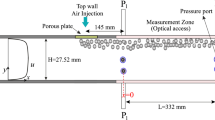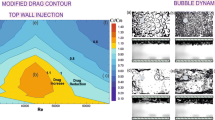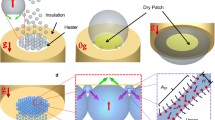Abstract
As air is injected into a flowing liquid, the resultant bubble characteristics depend on the properties of the injector, near-wall flow, and flowing liquid. Previous research has shown that near-wall bubbles can significantly reduce skin-friction drag. Air was injected into the turbulent boundary layer on a test section wall of a water tunnel containing various concentrations of salt and surfactant (Triton-X-100, Union Carbide). Photographic records show that the mean bubble diameter decreased monotonically with increasing salt and surfactant concentrations. Here, 33 ppt saltwater bubbles had one quarter, and 20 ppm Triton-X-100 bubbles had one half of the mean diameter of freshwater bubbles.









Similar content being viewed by others
References
Alves S, Maia C, Vasconcelos J, Serralheiro A (2002) Bubble size in aerated stirred tanks. Chem Eng J 89:109–117
Bogdevich V, Evseev A (1976) The distribution of skin-friction in a turbulent boundary layer of water beyond the location of gas injection. In: Migirenko GS (ed) Investigations of boundary layer control. Thermophysics Institute Publishing, Novosibirsk
Fried V, Hameka HF, Bulkis U (1977) Physical chemistry. MacMillan, New York
Kato H, Fuji Y, Yamaguchi H, Miyanaga M (1993) Frictional drag reduction by injecting high-viscosity fluid into a turbulent boundary layer. J Fluids Eng 115:206–212
Kawamura T, Moriguchi Y, Kato H, Kakugawa A, Kodama Y (2003) Effect of bubble size on the microbubble drag reduction of a turbulent boundary layer. ASME joint fluids engineering conference
Keitel G, Onken U (1982) Inhibition of bubble coalescence by solutes in air/water dispersions. Chem Eng Sci 37:1635–1638
Kitagawa A, Sugiyama K, Ashihara M, Hishida K, Kodama Y (2003) Measurement of turbulence modification by microbubbles causing frictional drag reduction. In: Proceedings of ASME fluids engineering division summer meeting, pp 1–7
Kunz R, Deutsch S, Landau J (2003) Two fluid modeling of microbubble turbulent drag reduction. In: Proceedings of ASME fluids engineering division summer meeting, pp 1–10
Lapham G, Dowling D, Schultz W (1999) In situ force-balance tensiometry. Exp Fluids 27:157–166
Lapham G, Dowling D, Schultz W (2001) Linear and nonlinear gravity-capillary water waves with a soluble surfactant. Exp Fluids 30:448–457
Legner H (1984) A simple model for gas bubble drag reduction. Phys Fluids 27:2788–2790
Lumley J (1977) Drag reduction in two phase and polymer flows. Phys Fluids 20:S64–S70
Machon V, Pacek A, Nienow A (1997) Bubble sizes in electrolyte and alcohol solutions in turbulent stirred vessel. Trans Ind Chem Eng 75A:339–347
Madavan N, Deutsch S, Merkle C (1984a) Reduction of turbulent skin-friction by microbubbles. Phys Fluids 27:356–363
Madavan N, Deutsch S, Merkle C (1984b) The effect of porous material on microbubble skin-friction reduction. Am Inst Aeronaut Astronaut, paper no 84-0348
Madavan N, Deutsch S, Merkle C (1985) Measurments of local skin-friction in a microbubble-modified turbulent boundary layer. J Fluid Mech 156:237–256
Meng J, Lovett J (1998) Microbubble hydrodynamic drag reduction: High speed subscale experiment and estimated improvements in full-scale implementation. NUWC-NPT technical report 11-038:1-52
Meng J, Uhlman J (1998) Microbubble formation and splitting in a turbulent boundary layer for turbulence reduction. In: Proceedings of the international symposium on seawater drag reduction, pp 341–355
Merkle C, Deutsch S (1992) Microbubble drag reduction in liquid turbulent boundary layers, Part 1. Appl Mech Rev 45(3):103–127
Sanders WC, Dowling DR, Perlin M, Ceccio SL (2004) Bubble friction drag reduction in a high Reynolds number flat plate turbulent boundary layer. J Fluid Mech (in press)
Schlichting H (1979) Boundary layer theory, 7th edn. McGraw-Hill, New York
Slauenwhite D, Johnson B (1999) Bubble shattering: Differences in bubble formation in fresh water and seawater. J Geophys Res 104(C2):3265–3275
Takahashi T, Kakugawa A, Nagaya S, Yanagihara T, Kodama Y (2001) Mechanisms and scale effects of skin-friction reduction by microbubbles. In: Proceedings of 2nd symposium on smart control of turbulence
Zieminski S, Whittemore R (1971) Behavior of gas bubbles in aqueous electrolyte solutions. Chem Eng Sci 26:509–520
Acknowledgements
The authors of this paper are grateful for the support of the Office of Naval Research under contract N00014-02-C-0468, Dr. L. P. Purtell, technical monitor.
Author information
Authors and Affiliations
Corresponding author
Rights and permissions
About this article
Cite this article
Winkel, E.S., Ceccio, S.L., Dowling, D.R. et al. Bubble-size distributions produced by wall injection of air into flowing freshwater, saltwater and surfactant solutions. Exp Fluids 37, 802–810 (2004). https://doi.org/10.1007/s00348-004-0850-y
Received:
Accepted:
Published:
Issue Date:
DOI: https://doi.org/10.1007/s00348-004-0850-y




